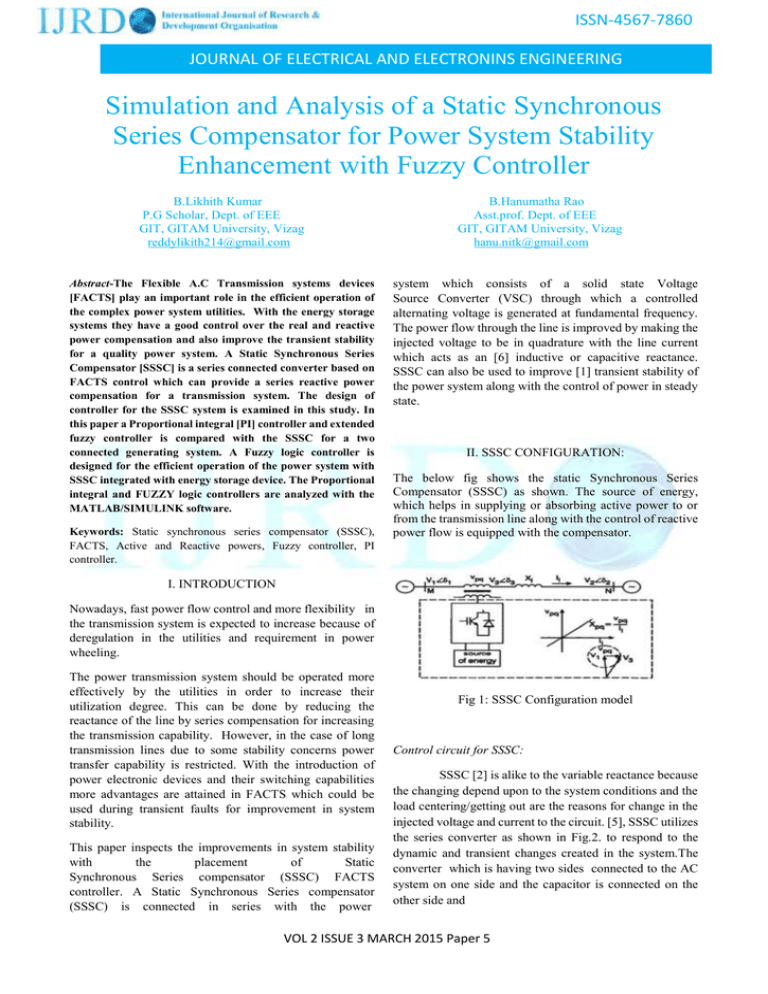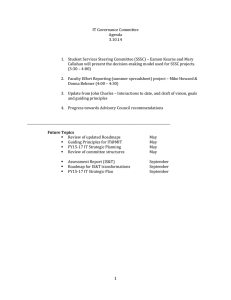Simulation and Analysis of a Static Synchronous Series
advertisement

ISSN-4567-7860 JOURNAL OF ELECTRICAL AND ELECTRONINS ENGINEERING Simulation and Analysis of a Static Synchronous Series Compensator for Power System Stability Enhancement with Fuzzy Controller B.Likhith Kumar P.G Scholar, Dept. of EEE GIT, GITAM University, Vizag reddylikith214@gmail.com Abstract-The Flexible A.C Transmission systems devices [FACTS] play an important role in the efficient operation of the complex power system utilities. With the energy storage systems they have a good control over the real and reactive power compensation and also improve the transient stability for a quality power system. A Static Synchronous Series Compensator [SSSC] is a series connected converter based on FACTS control which can provide a series reactive power compensation for a transmission system. The design of controller for the SSSC system is examined in this study. In this paper a Proportional integral [PI] controller and extended fuzzy controller is compared with the SSSC for a two connected generating system. A Fuzzy logic controller is designed for the efficient operation of the power system with SSSC integrated with energy storage device. The Proportional integral and FUZZY logic controllers are analyzed with the MATLAB/SIMULINK software. Keywords: Static synchronous series compensator (SSSC), FACTS, Active and Reactive powers, Fuzzy controller, PI controller. B.Hanumatha Rao Asst.prof. Dept. of EEE GIT, GITAM University, Vizag hanu.nitk@gmail.com system which consists of a solid state Voltage Source Converter (VSC) through which a controlled alternating voltage is generated at fundamental frequency. The power flow through the line is improved by making the injected voltage to be in quadrature with the line current which acts as an [6] inductive or capacitive reactance. SSSC can also be used to improve [1] transient stability of the power system along with the control of power in steady state. II. SSSC CONFIGURATION: The below fig shows the static Synchronous Series Compensator (SSSC) as shown. The source of energy, which helps in supplying or absorbing active power to or from the transmission line along with the control of reactive power flow is equipped with the compensator. I. INTRODUCTION Nowadays, fast power flow control and more flexibility in the transmission system is expected to increase because of deregulation in the utilities and requirement in power wheeling. The power transmission system should be operated more effectively by the utilities in order to increase their utilization degree. This can be done by reducing the reactance of the line by series compensation for increasing the transmission capability. However, in the case of long transmission lines due to some stability concerns power transfer capability is restricted. With the introduction of power electronic devices and their switching capabilities more advantages are attained in FACTS which could be used during transient faults for improvement in system stability. This paper inspects the improvements in system stability with the placement of Static Synchronous Series compensator (SSSC) FACTS controller. A Static Synchronous Series compensator (SSSC) is connected in series with the power Fig 1: SSSC Configuration model Control circuit for SSSC: SSSC [2] is alike to the variable reactance because the changing depend upon to the system conditions and the load centering/getting out are the reasons for change in the injected voltage and current to the circuit. [5], SSSC utilizes the series converter as shown in Fig.2. to respond to the dynamic and transient changes created in the system.The converter which is having two sides connected to the AC system on one side and the capacitor is connected on the other side and VOL 2 ISSUE 3 MARCH 2015 Paper 5 ISSN-4567-7860 JOURNAL OF ELECTRICAL AND ELECTRONINS ENGINEERING the battery which is used in the system should be assumed as a DC source. Assume if a dynamic change in system will be occurred, SSSC circuit works according to the control circuit in Fig.3 by using the converter the energy of battery will be converted to the ac form and then injecting this voltage to the circuit the changes will be damped properly. The control circuit as shown in Fig. 2 is utilized to control the active and reactive powers of bus-3, For controlling the active and reactive powers, firstly, sampling from the voltage and current is done and converted to dq0 values. Respective bus3 Active and reactive powers are calculated using their voltage and current in dq0 references and these references are compared with the determined reference and the produced error signal is given to the PI controllers. we are trying to achieve the zerosignal error by adjusting the parameters of the PI controllers, so that powers can follow the reference powers specifically. Therefore, the output of the controllers are transformed to the ABC reference and then given to the PWM. Fig 4: Equivalent control circuit for SSSC III. FUZZY LOGIC CONTROLLER The control system is based on fuzzy logic. Fuzzy logic controller [4] is a one type non linear controller and automatic controller. The decision-making process makes use of acceptance, ambiguity, inaccuracy and fuzziness approaching human reasoning in the decision-making process to offer a very satisfactory performance [7] which does not need mathematical model. Fig 8 shows the fuzzy logic controller block diagram [8] The proposed control system is based on the MAMDHANI fuzzy model which consists of four main parts. The input membership functions are fuzzified based on rule bases and the inferencing system, from which the outputs are produced which are defuzzified and are applied to the main control system. Fig 2: SSSC configuration circuit Simulink model Fig 5: Block Diagram of fuzzy logic controller Fig 3: Simulated control circuit VOL 2 ISSUE 3 MARCH 2015 Paper 5 ISSN-4567-7860 JOURNAL OF ELECTRICAL AND ELECTRONINS ENGINEERING Fig 7: Two machine model simulation circuit model for SSSC V. SIMULATION RESULTS The below fig. 8 shows the matlab/ Simulink model for the SSSC (Static synchronous series compensator) with fuzzy controller and without fuzzy controller. Fig 6: selection of input and output variables TABLE I: FUZZY RULES Fig 8: Simulink model for SSSC IV. MODEL OF TWO MACHINE POWER SYSTEM Real time voltage and current waveforms are used to present the dynamic performance of SSSC. The system shown in Fig. 4 has been obtained using MALAB software. In order to control the power flow in the 500 KV transmission systems one SSSC has been placed in the simulation. This system is made in ring mode and consists of 4-buses (B1 to B4) connected to each other through three phase transmission lines. L1, L2-1, L2-2 and L3 with the length of 280, 150, 150 and 5 km respectively. Two power plants having phase-to phase voltage equal to 13.8 kV are used in the system to supply the load.[3] Parameters like active and reactive powers injected by the plants to the power system are considered in per unit using base parameters Sb = 100 MVA and Vb = 500 KV, which are (24-j3.8) and (15.6-j0.5). Fig 9: voltage and current at bus1 Fig 10: voltage and current at bus 2 VOL 2 ISSUE 3 MARCH 2015 Paper 5 ISSN-4567-7860 JOURNAL OF ELECTRICAL AND ELECTRONINS ENGINEERING Fig 11: voltage and current at bus 3 Fig 12: voltage and current at bus 4 infinite bus power system to damp sub synchronous resonance. During all the test conditions, we have observed that Fuzzy Logic Controller is able to damp the oscillations more quickly than PI controller and also which provide fast settling time and power oscillations damping. Applications of the SSSC will be extended in future to a complex system to investigate the problems related to the various modes of power oscillation in the power systems. REFRERENCES [1] Makkar, C.R. and L. Dewan, 2010. Transient Stability Enhancement using Robust FACTS Controllers- A Brief Tour. Canadian J. Elect. Electron. Engineer, 1: 150-155. Padma, S. and R. Lakshmipathi, 2010. Fig 13: Active and reactive power at bus 1 [2] Static Synchronous Series Compensator (SSSC) with Superconducting Magnetic Energy Storage (SMES) for the enhancement of transient stability in multi-area system. Proceedings of the International Conference on Advances in Electrical and Electronics, Tamilnadu, India, pp: 39-43. Panda, S., 2010. [3] Modelling, simulation and optimal tuning of SSSCbased controller in a multimachine power system. World J. Model. Simulation, 6: 110-121. Pratumsuwan, P., S. Thongchai and S. Tansriwong, 2010. Fig 14: Active and reactive power at bus 2 [4] A hybrid of fuzzy and proportional-integralderivative controller for electro-hydraulic position servo system. Energy Res. J., 1: 62-67. DOI: 10.3844/erjsp.2010.62.67 Saha, S.K., 2010. [5] Reliability contingency analysis by static synchronous series compensator in optimal power flow. Int. J. Comput. Elect. Engineer, 2: 908-911. Sahay, K. and B. Dwivedi, 2009. Fig 15: Active and reactive power at bus3 [6] Super capacitors energy storage system for power quality improvement: An overview. J. Elect. Syst. http://journal.esrgroups.org/jes/papers/5_4_8.pdf Samuel, N.N., 2010. [7] An intelligent fuzzy logic controller applied to multiarea load frequency control. Am. J. Sci. Ind. Res., 1: 220-226. DOI: 10.5251/ajsir.2010.1.2.220.226 Shakarami, M.R. and A. Kazemi, 2010. Fig 16: Active and reactive power at bus 4 [8] Singh B N, Chandra A, Al-Haddad K and Singh B (1999), “Performance of Sliding Mode and Fuzzy Controllers for a Static Synchronous Series compensator”, IEEE Proceedings on the No. 19990072, IEEE. CONCLUSION This paper investigated the comparison between PI and Fuzzy Logic based controller of SSSC in a two machine VOL 2 ISSUE 3 MARCH 2015 Paper 5


